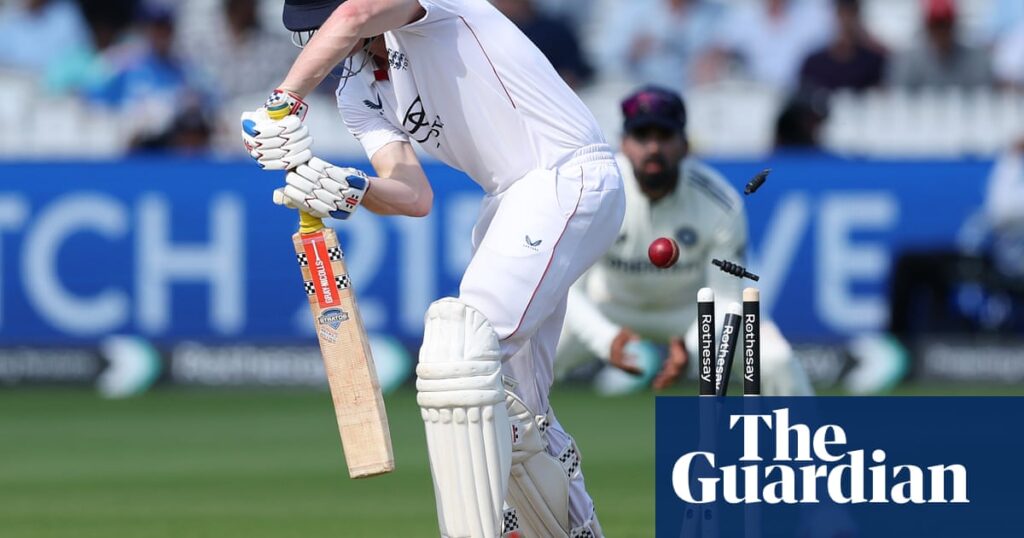High summer can be hard going at Lord’s. It was tough enough on the spectators, who worked up a sweat just standing in the queues to get in to the ground. If you had seats in the open terraces at the bottom of the Edrich, Compton and Mound Stands, where you get slow-roasted by the sun as it makes its way slowly above the pavilion, your best bet was to make for the shade round by the Nursery Ground. It was too darn hot to sit and watch cricket and a lot of the cricket wasn’t worth watching anyway. The conditions meant the players seemed to be on a go-slow, England’s run rate was sickly and India’s over rate appeared, at one point, to have given up and died.
It was one of those afternoons when no matter what was actually happening out in the middle, any time you looked up to watch, someone always seemed to be playing a forward defence against Nitish Kumar Reddy. He runs in so slowly that it’s like watching an optical illusion. He almost seems to be moving backwards, like a man losing ground on a treadmill. The mysteries of the Lord’s pitch made medium pace all but unplayable, and the best of England’s batsmen were entirely unable to find their timing so, on the occasions they actually connected with the ball, it invariably clacked off the bat and dribbled into the outfield.
After lunch, when Jasprit Bumrah was on from one end and Mohammed Siraj the other, Joe Root and Ollie Pope played a stretch of 28 consecutive dot balls. There were nine scoring shots in an hour and altogether they scored 70 in 24 overs between lunch and tea, which made it the slowest session in terms of run rate they’ve played in a Test in the past three years. Sports fans tend to have short memories, but as the afternoon wore on it was just about possible to recall that one of the reasons England gave up playing this sort of cricket in the first place was because it takes you nowhere, slowly, and apart from Root, they aren’t especially well-suited to it anyway.
It all felt oddly deferential to ideas about the way the game is supposed to be played. The old sticks insisted it was “proper cricket”. Truth is it was pretty soporific. In among it all, there was one bit of snap-out-of-it cricket, right after Pope got out caught behind. With Harry Brook in, Shubman Gill decided to bring Bumrah back into the attack, pitching the world’s No 1-ranked bowler against the world’s No 1-ranked batsman. Bumrah had bowled, by his own high standards, ordinarily in the morning. He hadn’t quite been able to find the right line. But he bowled Brook with a quick nip-backer that ripped right through his forward defence.
It was a reminder, if anyone needed it, that this Indian team have the ability to rip this match away from England in a hot minute if they get the opportunity. They seem to have achieved something no amount of media coverage or public criticism ever has and made Stokes’ England change the way they go about playing. No doubt what happened at Edgbaston, when India scored 587 after being put into bat, was behind Stokes’ decision to make India field when he won the toss this time around. It is only the second time he’s done that in England since he became their full-time captain.
And no doubt, too, that Gill’s absolutely ruthless batting in that match had an influence on England’s determination not to squander this innings in a flurry of wanton attacking shots. Instead, they spent a large part of the day playing the sort of sluggish cricket that Stokes foreswore a long time ago, and at stumps they had the sort of stuck-in-the-middle total that might not add up to much at all if they happen to collapse in the morning.
after newsletter promotion
As the day went on, some strange sleight of time meant the game seemed to stop altogether. At one point, the 30,000-odd people inside the ground spent a good five minutes watching three umpires bend over a briefcase while they tried to find yet another replacement ball. It was the only thing going on on the outfield. The players stood around, as stationary as the little white clouds that seemed to have been painted into place overhead. At another, play stopped for three minutes while some flying ants hovered over the pitch. It probably wasn’t the day to try to persuade your friend who’s never seen a game why they ought to get into Test-match cricket.


